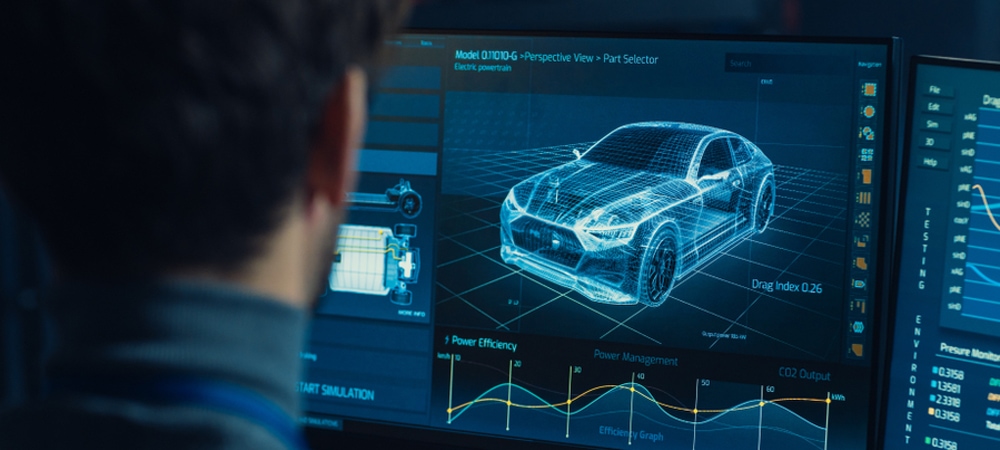Everyone is talking about AI, and it is certainly a big topic for the future – especially in manufacturing. How far along is the development of AI in intralogistics?
Bjoern Dunkel: If we look at supply chain management as a whole, then there are already a lot of subareas where AI can be beneficial. For example in route planning, where the route has to change suddenly due to traffic jams or because a supposedly longer route could mean shorter travel time. At GIB, however, we focus on the internal supply chain, meaning everything that concerns intralogistics. Here, too, there are already approaches to improve processes. One example would be how sales forcasts can make better and more reliable predictions through the use of artificial intelligence. With the help of an artificial neural network, software today can learn from mistakes of the past so that it achieves better and better results over time. Of course, we are still a long way from achieving this today, but preparations are already well underway.
In which subarea of intralogistics can you imagine the use of AI or are you perhaps already working with it?
Dunkel: By refining the SAP standard, we at GIB can offer specialized supply chain software for demand planning, production planning, collaboration with suppliers, material requirements planning, and inventory management. Especially quality management to round out production processes can be enhanced by leveraging AI – namely, if image recognition is used to distinguish between good and bad parts. An automated exclusion process ensures that only good parts reach any subsequent processing stages. This use case has a lot of potential because the exclusion process is still done manually in many factories today. Combining 3D image recognition and artificial neural networks, for example, offers massive optimization possibilities in quality management, as parts can be inspected directly in the production process without human intervention and automatically assigned to the next production step. This eliminates potential sources of error, reduces the processing time, and immediately detects defective parts.
So, quality assurance would be an area of application for AI. Where are you already using calculations based on neural networks at GIB?
Dunkel: We are still at the very beginning with the use of AI in our software. In fact, this is the first time ever that we are using real AI in our supply chain solution, which is capable of determining an exact safety stock through learning via neural networks. The system therefore has to first prove itself in real-life scenarios. Only then will we see whether our artificial intelligence also works under real conditions. However, we are already working on other possible use cases for AI. A team of our developers is already researching beneficial applications in sales forecasting.
Let’s talk about big data. Today, enormous amounts of data are generated by sensor technology. What happens with said data?
Dunkel: We have to keep in mind that big data is not the goal, but at most a means to an end. In the case of AI, it is a blessing. AI solutions only work properly if they are fed with a great deal of data and information. In the learning process, more is more – at least if the formulated question is correct and the algorithms work well. The fact that we are now not only able to collect these enormous amounts of data, but also to store them and make them available for further use, is the acceleration that neural networks needed. So, the question we have to ask ourselves now is: What happens to the sensor data that is collected at the production level?
How has this challenge been solved so far?
Dunkel: Up to now, the evaluation of sensor data had to happen in rather close proximity to the machine. In other words, the health status of the machine, for example, is displayed directly in the system in the plant. There was and still often is a strict separation between OT and IT, i.e. between production and business process control. However, better security concepts and technologies have increasingly led to opening up production IT, not least because digitalization makes this step necessary and the benefits of vertical networking of supply chain processes offer enormous competitive advantages. At GIB, we have developed a solution that is able to bring aggregated sensor data into the ERP system. This means that we not only digitize business processes horizontally along the value chain, but are also able to digitally map the production level. I am certain that targeted use of AI will be a decisive success factor, especially when it comes to big data.
How do you intend to make better use of big data with the help of AI?
Dunkel: Data only makes sense if you put it in context. When I walk through the factory, I do want to see what has been planned through the ERP system and be proactively alerted by my device, e.g., my cellphone, that productivity is particularly high or particularly low in the machine I’m standing in front of. However, this information alone is of no use to me; I have to put it in context. In the mass of data that the sensors collect, there is information about parameters that can influence my production, such as air pressure, the temperature in the hall, or humidity. And if I contextualize this information now, I know which orders were being processed on this machine at the time. I know what capacity utilization the machine had, what materials were produced on it. And if I notice again and again that there are quality issues at a certain point in time, I can look at the data that was collected at the same time on the shopfloor level.
What can users conclude from this?
Dunkel: Such derivations and correlations cannot be processed with a pencil and a calculator. There are too many variables that all influence each other. AI could be the solution here. The AI solution recognizes patterns and correlations, evaluates the situation in its entirety, and provides the best possible solutions for the respective user or for the best production sequence in any given situation. Overall, contextualization is central to the optimization of intralogistics. We like to use the term CLUI, which stands for context-based, location-based, and user-based information. So, our goal is to address the right information correctly, exactly where and when you need it.
So you’re saying that production planning can be optimized through big data and AI?
Dunkel: Yes, exactly. An incredible amount of data is available via sensor technology. That means we have a data pool that we can use. AI automatically makes the decision which combination of products is the optimal one with the temperature, humidity, or other parameters forecasts for the day. This can significantly reduce the number of bad parts being produced. These are use cases that aren’t far off, actually, because the know-how is already there.
Is this how OT and IT grow closer together?
Dunkel: Yes, you could say that. In this context, we like to talk about the “Y path,” which means that we are bringing together operation technology and information technology in one system. Of course, not all shopfloor data can be fed into the ERP system – the terabytes upon terabytes of data would blow up any ERP system. The trick is to select which data plays a role in the digital mapping of the production level in the ERP. In other words, which data is needed to bring the “digital twin” to life? We then pull this data into the mass data storage and can use it later for evaluations, interpretations, or AI use cases.
Do you think that in the future, thanks to AI, a warehouse could be able to send orders to suppliers on its own?
Dunkel: Yes, absolutely. Our vendor-managed inventory tool, VMI, is already heading in that direction as a digital link to the supplier. You might not believe it, but 90 percent of B2B orders to suppliers today are still sent in an e-mail. That means that only when an e-mail arrives does the supplier know what the customer actually needs from them. Our VMI solution creates transparency and plannability for the supplier and, at the same time, relieves the customer in their demand planning. The supplier can view all the information relevant to them at any time and use it to plan which delivery call-offs are scheduled and which stocks will soon be depleted, for example. Another positive effect is that the supplier can use it to make their own processes more economical and cost-effective. This, in turn, often has a positive effect on customer relationship management.
So the reorder level is the decisive factor?
Dunkel: If we take a closer look at our existing VMI solution to see where AI could be used in a meaningful way, then the reorder level would certainly be a good starting point. Referring to our climate example from earlier, the empirical values from the past could be related to external factors, such as humidity, pressure, and temperature. A smart AI solution assesses the current situation, recommends an adjusted “recipe” for production, and triggers the required shipping notification for the best supplier on time..
Do you think that AI brings us closer to the perfect supply chain?
Dunkel: That is indeed our goal. If we look at the indicator system of our Supply Chain Excellence solution, SCX, for example, we give supply chain managers a key performance indicator that informs them about the quality of their supply chain processes at a glance. This key performance indicator is, of course, based on a large number of key performance indicators (KPIs), which in turn are based on the SAP data core – big data. Currently, our supply chain evaluation system is defined by many complex algorithms, and as we incorporate more and more intelligence and thus more and more key performance indicators, the complexity of the system will also increase significantly. We will eventually reach our limits with this traditional way of programming. That’s why we will focus on using artificial intelligence in the future.


















![gib supply chain big data AI [shutterstock: 1536997286, metamorworks]](https://e3zine.com/wp-content/uploads/2021/04/gib-supply-chain-big-data-AI-shutterstock_1536997286-e1618391552165.jpg)


Add Comment